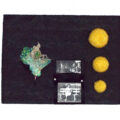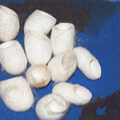Objekte
ASSEMBLAGEN
Glasobjekte
- Glass Objects I
- Glass Objects II
- Glass Objects III
- Glass Objects IV
- Glass Objects V
- Glass Objects VI
- Glass Objects VII
- Glass Objects VIII
- Glass Objects IX
- Glass Objects X
- Glass Objects XI
- Glass Objects XII
- Glass Objects XIII
- Glass Objects XIV
- Glass Objects XV
- Glass Objects XVI
- Glass Objects XVII
- Glass Objects XVIII
- Glass Objects XIX
- Glass Objects XX
- Flagg Objects
- Guardians of my Egos
Archives of Remains
The starting point for this series was the discovery of a roll of roofing felt in the cellar, which I originally intended to take to the recycling centre but then forgot to take with me. As this material is a remnant from a creative period in which I increasingly worked with building materials and used it to create the Black Triptych - (101 x 75 cm each) in 1995, the idea of dealing with my leftovers, remnants from the past, was an obvious one.
I have also been thinking for some time about how I could achieve layering with the materials I am currently working with.
500 roofing felt, sanded on both sides, was used to seal flat pitched roofs and can be bonded together with heat on the surface. As the black cardboard heats up very much on the roofs and there is a risk of the material becoming very soft and possibly detaching from the roof boarding, the fine grain of the applied sand is intended to reflect the sun and thus reduce the heating. Today, flat roofs are sealed with bitumen sheeting, both materials are oil products and not very environmentally friendly.
The idea of processing leftovers almost inevitably led me to think about what content and design possibilities could be associated with this. At the same time, these remnants are interwoven with memories of different stages of life, childhood stories and people, creative periods and suddenly a network of relationships emerges, which I was not aware of, but which I find very exciting.
The multitude of very different materials results in assemblages. These are approx. 30 x 24 x 10 cm in size and I describe them as experiments, on the one hand to explore creative possibilities and on the other to approach my past through the materiality of the materials. I call them experiments also, because there could be always several possibilities.
Experiment 9 - Grandmother - is a very exciting relationship for me:
I never met my grandmother, but my grandparents' tailoring was present in my mother's conversations and memories. My mother did an apprenticeship as a tailor in her parents' tailoring workshop, which she was unable to complete due to the war.
I learnt to sew at secondary school and made my first clothes at home on the old Singer sewing machine from the tailor's workshop. As I sewed my own clothes for many years, the assemblage combines a souvenir photo of my grandmother in 1936 in front of her tailor's workshop, old spools of thread from that time and new pattern sheets that I used for my clothes. You can see from the photo that my grandparents already used pattern sheets for women's outerwear back then. This creates a connection between three generations through tailoring.
But the individual experiments not only tell stories, stories that have to do with my past and artistic engagement with our living environment, but also testify to the connection with the many people behind these materials and their production. They are also an expression of the use and exploitation of our earth's resources and, in a way, also represent the rubbish that we and I in particular leave behind. This archive is intended to pay a small tribute to the "leftovers" that would otherwise end up in the incinerator.
















